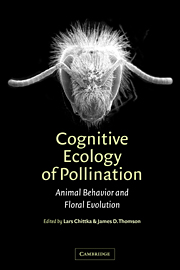Book contents
- Frontmatter
- Contents
- List of contributors
- Preface
- 1 The effect of variation among floral traits on the flower constancy of pollinators
- 2 Behavioral and neural mechanisms of learning and memory as determinants of flower constancy
- 3 Subjective evaluation and choice behavior by nectar-and pollen-collecting bees
- 4 Honeybee vision and floral displays:from detection to close-up recognition
- 5 Floral scent, olfaction, and scent-driven foraging behavior
- 6 Adaptation, constraint, and chance in the evolution of flower color and pollinator color vision
- 7 Foraging and spatial learning in hummingbirds
- 8 Bats as pollinators: foraging energetics and floral adaptations
- 9 Vision and learning in some neglected pollinators: beetles, flies, moths, and butterflies
- 10 Pollinator individuality: when does it matter?
- 11 Effects of predation risk on pollinators and plants
- 12 Pollinator preference, frequency dependence, and floral evolution
- 13 Pollinator-mediated assortative mating: causes and consequences
- 14 Behavioural responses of pollinators to variation in floral display size and their influences on the evolution of floral traits
- 15 The effects of floral design and display on pollinator economics and pollen dispersal
- 16 Pollinator behavior and plant speciation: looking beyond the “ethological isolation” paradigm
- Index
3 - Subjective evaluation and choice behavior by nectar-and pollen-collecting bees
Published online by Cambridge University Press: 13 August 2009
- Frontmatter
- Contents
- List of contributors
- Preface
- 1 The effect of variation among floral traits on the flower constancy of pollinators
- 2 Behavioral and neural mechanisms of learning and memory as determinants of flower constancy
- 3 Subjective evaluation and choice behavior by nectar-and pollen-collecting bees
- 4 Honeybee vision and floral displays:from detection to close-up recognition
- 5 Floral scent, olfaction, and scent-driven foraging behavior
- 6 Adaptation, constraint, and chance in the evolution of flower color and pollinator color vision
- 7 Foraging and spatial learning in hummingbirds
- 8 Bats as pollinators: foraging energetics and floral adaptations
- 9 Vision and learning in some neglected pollinators: beetles, flies, moths, and butterflies
- 10 Pollinator individuality: when does it matter?
- 11 Effects of predation risk on pollinators and plants
- 12 Pollinator preference, frequency dependence, and floral evolution
- 13 Pollinator-mediated assortative mating: causes and consequences
- 14 Behavioural responses of pollinators to variation in floral display size and their influences on the evolution of floral traits
- 15 The effects of floral design and display on pollinator economics and pollen dispersal
- 16 Pollinator behavior and plant speciation: looking beyond the “ethological isolation” paradigm
- Index
Summary
During the last 30 years, animal behaviorists have become serious players in the quest to understand the interaction between plants and their flower-visiting, foraging pollinators (Waddington 1983, 1997; Barth 1985). Flower-visiting bees, flies, butterflies, and beetles are the sole agents for reproduction in many species of plants. Through the larder of pollen and nectar they provide, plants also affect the foraging success and reproductive output of these insects. The pollinator and the plant, each of separate evolutionary lineages, are in a long-term game where each is dependent on the other and each affects the evolution of the other (Selten & Shmida 1991).
On a local scale, in a field of flowers, a forager such as a nectar-collecting bee makes thousands of sequential decisions during a foraging trip. These decisions are reflected in the choice of flowers visited. These decisions determine: which flowers receive visits and which do not; who mates with whom; the distance between mating plants; the transfer of intra- or interspecific pollen; and the amount of self-pollination and outcrossing. The decisions also affect the bee's success on its foraging foray. Through experience, the bee makes associations between different kinds of flowers (e.g., species) and the rewards they provide, and it seeks out the flowers with the greatest net rewards. Animal behaviorists have played an important role in learning how pollinators make these choices among flowers.
Although general patterns of pollinator foraging behavior have been found, variation among individual foragers has not been well studied.
- Type
- Chapter
- Information
- Cognitive Ecology of PollinationAnimal Behaviour and Floral Evolution, pp. 41 - 60Publisher: Cambridge University PressPrint publication year: 2001
- 25
- Cited by



